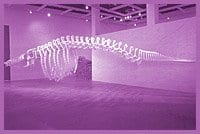According to The Globe And Mail’s Sarah Milroy, The Power Plant’s pair of summer shows Bounce and In Through The Out Door, is like the art world version of the Leafs versus the Canucks. The curators, Philip Monk and Xandra Eden respectively, face off three artists from Vancouver and three from Toronto. Although Monk, in his curator’s talk on Jul 10, denied that there was any intention to create a competitive scenario, he didn’t seem entirely unhappy at the suggestion.
There’s no denying the rivalry between these two cities, one that spills beyond their art communities to the realms of sports teams, quality of life, ski resorts and attitude. In this particular case, in Milroy’s view, Vancouver gives Toronto a sound whumping.
At the very least, the curators did coordinate certain key aspects of the two shows: three artists from each city in each show, all considered mid-career artists, all dealing with space in some sculptural and/or conceptual way. Whether they deny it or not, the set up seems made for a compare and contrast exercise. Even the press release declares them “tag team exhibitions.”
But rather than see it as a competition, a more compelling angle is to see the two shows as complements. Think of two siblings in a large family, the eldest, reserved and introspective, and the youngest, garrulous, irrepressible, resorting to acrobatics to claim a share of the attention. You get two related, yet distinct worldviews. In In Through The Out Door, art is a daydreamer’s refuge; in Bounce, art is a playground.
For In Through The Out Door, Eden groups together Torontonians David Armstrong-Six, Nestor Krüger and Germaine Koh. As the title suggests, there is a quiet sense of going against convention, playing with established parameters.
Koh’s Fair-Weather Forces: Wind Speed is a turnstile revolving on its own, connected to an anemometer outside to reflect wind speed at the shore of the lake. For Prayers, Koh has rigged a computer console to send smoke signals. You type a prayer into the computer, which in turn translates it into puffs of smoke released into the ether from the roof of the gallery, just outside the main entrance.
Armstrong-Six’s Antimatter Island, created from tinted plexiglass panels, is what I can only describe as a Darth Vader mask gazebo (or cave or bus-shelter), an unlikely and intriguing sculpture that you can step inside.
Nestor Krüger’s video installation, Two Turntables, projects a digital animation of a stand of linden trees on opposite walls of a dark room. The lindens, in delicious gray tones, rotate around you as you stand in the room, which functions like a glade, a clearing in the forest. The speed of the trees’ rotation varies and accompanying these variations is the sound of some indeterminate machinery, a decidedly unnatural sound. The constant whirring is hypnotic, and reproduces in an alternate way the wonder of a walk in the forest. It is a place you could easily spend hours.
In Bounce, Philip Monk brings together Vancouverites Brian Jungen, Damian Moppett and Myfanwy MacLeod, whose works articulate a rebellion of another sort. Not only do the artists play with the materials of mass culture – Coleman coolers, picnic tables and skateboard parks – they also take on Vancouver’s tradition of photo-conceptualism (think Jeff Wall, Ian Wallace, Ken Lum), a school now perceived by some as a stodgy boys club.
Brian Jungen creates a whale skeleton from the kind of white plastic deck chairs you can buy at Canadian Tire. The piece, Cetology (Bowhead), induces awe for its size – it completely inhabits the gallery space in an imposing natural history museum way – but also for its conception, the how-did-he-put-that-together factor. Once you have digested these two things, Jungen’s comment on what lasts and plastic as artifact comes through.
Myfanwy MacLeod’s two pieces The Tiny Kingdom, an oversized, cartoonish outhouse, and Woodpile, repeated concrete casts of split firewood, create together a hillbilly theme park, complete with a picnic table inscribed in looping script (“Myfanwy was here”). The effect is one of childish pleasure and exuberance as MacLeod pokes fun at the warped and closed world of the photo-conceptualists.
The only installation that doesn’t live up to its conceptual billing is Damian Moppett’s pairing of a skateboard park maquette and drawings based on paintings of peasant bacchanals by Rubens. The idea is to contrast old and new versions of low, or popular, culture. The quality of the drawings is “scrumptious,” as I heard one gallery goer describe them. They are loosely rendered in muted tones, which highlight the frenzied activities they depict. And, beside them, the cool architecture of the maquette doesn’t stand a chance. If it was meant as a foil for the messy humanity of the drawings, it instead gets lost as an inert, uninhabited island.
Together, though, these two exhibitions engage intelligently with the idea, not to mention the materials, of summer: deck chairs, coolers, picnic tables, al fresco revelry, outhouses, shady forests, gazebos, tinted lenses, cloud-watching, summer breezes. There is the quality of letting your mind un-focus and drift, as well as that of recreation and entertainment.
The works bring the outside in, and evaporate the gallery walls to deliver an excellent summer diversion.
Bounce.
In Through the Out Door.
$4. Till Mon, Sep 2.
The Power Plant.
231 Queen’s Quay W.
(416) 973-4949.

 Why you can trust Xtra
Why you can trust Xtra


